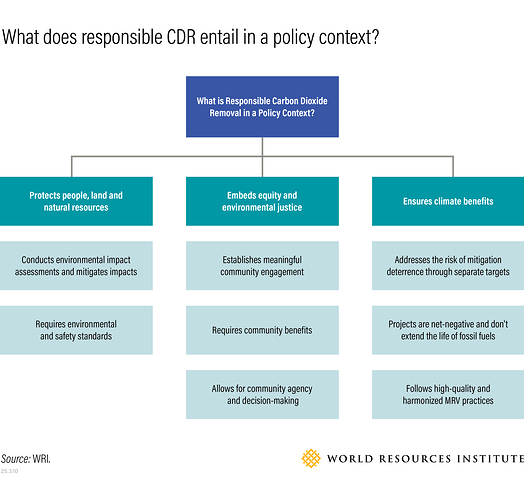In a post that has been recently published by the World Resources Institute, Hannah Harasaki, Danielle Riedl and Haley Leslie-Bole have elaborated on the ways in which CDR activities can be carried out responsibly.
Key takeaways:
- Besides removing CO2 from the atmosphere, CDR technologies generate societal and environmental co-benefits by creating a new sector that offers employment opportunities, enhancing soil health and decreasing ocean acidification at the local level.
- That said, engagement with CDR may create adverse effects. Therefore, adequate governance schemes should be implemented to reduce harm to the greatest extent possible.
- Governance schemes should be tailored to the unique features possessed by CDR methods and regulate them in an all-encompassing manner. If the governance schemes possess the latter features, they can prevent oil and gas companies from engaging in CDR as a pretext for producing fossil fuels. In addition, they can safeguard groups tackling harm caused by the fossil fuel industry from damage that may be inflicted through the use of land as well as water and energy resources as a result of CDR.
- Different long-term targets should be set for CDR and emission reductions by following the examples that have been set by some US states such as California and Washington. It may be easier to ensure that this separation takes place in locations that already seek to achieve net-zero and decrease emissions.
- CDR targets should be set following a quantitative evaluation of the anticipated amount of emissions that will be generated in hard-to-abate sectors so as to ensure that CDR is not used as a tool to compensate for emissions that can plausibly be decreased.
- Net-negative CDR should be facilitated by ensuring the generation of renewable energy for exclusive use during CDR activities like DAC that require a high amount of energy.
- Following the precedent that has been set by some states such as California, engagement in enhanced oil recovery that requires reliance upon CO2 captured via CDR for oil extraction purposes should be banned.
- Measurement, reporting and verification (‘MRV’) schemes that play a crucial role in ensuring that CDR projects are carried out in a responsible manner by demonstrating that they are net-negative and permanently remove CO2 suffer from the absence of uniform standards. This situation, in turn, poses obstacles against the formulation criteria to ensure that MRV schemes are suitable. This challenge can be overcome by tasking an independent governmental body that cannot be influenced by commercial CDR interests with overseeing whether or not MRV schemes function adequately.
- Policymakers should establish rules to ensure that the conditions of marginalized groups are not worsened by those that engage in CDR by requiring them to consult with local communities.
- CDR projects can rely upon innovative schemes by either distributing a share of their profits to the communities where they operate or giving them equity shares in their CDR business.
- CDR operators should be required to carry out environmental impact assessments and adhere to strict environmental and safety rules.
To read the post, visit:
https://www.wri.org/technical-perspectives/responsible-carbon-dioxide-removal#:
